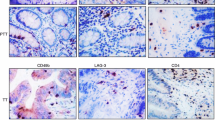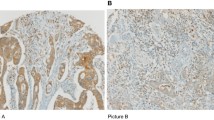Abstract
The human immune system consists of a balance between immune surveillance against non-self antigens and tolerance of self-antigens. CD8+ T cells and CD4+ regulatory T cells (Tregs) are the main players for immune surveillance and tolerance, respectively. We examined immunohistochemically the immunological balance at the tumor site using 94 surgically resected colorectal cancer tissues. Forkhead box P3 (FOXP3)+ cells were considered to be Tregs in the present study. The number of intratumoral FOXP3+ cells (itFOXP3+ cells) was positively correlated with lymph node metastases (P = 0.030). itCD8+ T/itFOXP3+ cell ratio negatively correlated with pathological stages (P = 0.048). Next, relationship between the number of itCD8+ T cells or itFOXP3+ cells and survival prognosis in 94 patients who underwent a curative resection was analyzed. Only itCD8+ T/itFOXP3+ cell ratio positively correlated with disease-free survival (0.023) and overall survival (P = 0.010). Multivariate analysis indicated that itCD8+ T/itFOXP3+ cell ratio is an independent prognostic factor (P = 0.035) of overall survival. The number of itFOXP3+ cells positively correlated with transforming growth factor-beta TGF-β production at the tumor site (P = 0.020). In conclusion, itCD8+ T/itFOXP3+ cell ratio is a predictive marker for both disease-free survival time and overall survival time in patients with colorectal cancer. Importantly, itCD8+ T/itFOXP3+ cell ratio may be an independent prognostic factor. And, tumor-producing TGF-β may contribute to the increased number of itFOXP3+ cells.



Similar content being viewed by others
Abbreviations
- Tregs:
-
CD4+ regulatory T cells
- FOXP3:
-
Forkhead box P3
- itCD8+ T cells:
-
Intratumoral CD8-positive T cells
- itFOXP3+ cells:
-
Intratumoral FOXP3-positive cells
- itCD8+ T/itFOXP3+ cell ratio:
-
Ratio of number of intratumoral CD8-positive T cells to number of intratumoral FOXP3-positive cells
- TILs:
-
Tumor-infiltrating lymphocytes
- PBMCs:
-
Peripheral blood mononuclear cells
- TGF-β:
-
Transforming growth factor-beta
References
Akbar AN, Vukmanovic-Stejic M, Taams LS et al (2007) The dynamic co-evolution of memory and regulatory CD4+ T cells in the periphery. Nat Rev Immunol 7:231–237
Bates GJ, Fox SB, Han C et al (2006) Quantification of regulatory T cells enables the identification of high-risk breast cancer patients and those at risk of late relapse. J Clin Oncol 24:5373–5380
Berendt MJ, North RJ (1980) T-cell-mediated suppression of anti-tumor immunity An explanation for progressive growth of an immunogenic tumor. J Exp Med 151:69–80
Boon T, Cerottini JC, Van den Eynde B et al (1994) Tumor antigens recognized by T lymphocytes. Annu Rev Immunol 12:337–365
Chen W, Jin W, Hardegen N et al (2003) Conversion of peripheral CD4+ CD25− naive T cells to CD4+ CD25+ regulatory T cells by TGF-beta induction of transcription factor Foxp3. J Exp Med 198:1875–1886
Cohen AM, Tremiterra S, Candela F et al (1991) Prognosis of node-positive colon cancer. Cancer 67:1859–1861
Curiel TJ, Coukos G, Zou L et al (2004) Specific recruitment of regulatory T cells in ovarian carcinoma fosters immune privilege and predicts reduced survival. Nat Med 10:942–949
Drake CG, Jaffee E, Pardoll DM (2006) Mechanisms of immune evasion by tumors. Adv Immunol 90:51–81
Dunn GP, Bruce AT, Ikeda H et al (2002) Cancer immunoediting: from immunosurveillance to tumor escape. Nat Immunol 3:991–998
Fantini MC, Becker C, Monteleone G et al (2004) Cutting edge: TGF-beta induces a regulatory phenotype in CD4+CD25− T cells through Foxp3 induction and down-regulation of Smad7. J Immunol 172:5149–5153
Fu J, Xu D, Liu Z et al (2007) Increased regulatory T cells correlate with CD8 T-cell impairment and poor survival in hepatocellular carcinoma patients. Gastroenterology 132:2328–2339
Galon J, Costes A, Sanchez-Cabo F et al (2006) Type, density, and location of immune cells within human colorectal tumors predict clinical outcome. Science 313:1960–1964
Gao Q, Qiu SJ, Fan J et al (2007) Intratumoral balance of regulatory and cytotoxic T cells is associated with prognosis of hepatocellular carcinoma after resection. J Clin Oncol 25:2586–2593
Grabenbauer GG, Lahmer G, Distel L et al (2006) Tumor-infiltrating cytotoxic T cells but not regulatory T cells predict outcome in anal squamous cell carcinoma. Clin Cancer Res 12:3355–3360
Hashimoto K, Nio Y, Sumi S et al (2001) Correlation between TGF-b1 and p21 (WAF1/CIP1) expression of matrix metalloproteinases (MMPs) and tissue inhibitors of the matrix metalloproteinases (TIMPs) in human pancreatic carcinoma. Pancreas 22:341–347
Hiraoka N, Onozato K, Kosuge T et al (2006) Prevalence of FOXP3+ regulatory T cells increases during the progression of pancreatic ductal adenocarcinoma and its premalignant lesions. Clin Cancer Res 12:5423–5434
Hori S, Nomura T, Sakaguchi S (2003) Control of regulatory T cell development by the transcription factor Foxp3. Science 299:1057–1061
Jass JR (1986) Lymphocytic infiltration and survival in rectal cancer. J Clin Pathol 39:585–589
Ling KL, Pratap SE, Bates GJ et al (2007) Increased frequency of regulatory T cells in peripheral blood and tumour infiltrating lymphocytes in colorectal cancer patients. Cancer Immun 7:7
Liyanage UK, Moore TT, Joo HG et al (2002) Prevalence of regulatory T cells is increased in peripheral blood and tumor microenvironment of patients with pancreas or breast adenocarcinoma. J Immunol 169:2756–2761
Loddenkemper C, Schernus M, Noutsias M et al (2006) In situ analysis of FOXP3+ regulatory T cells in human colorectal cancer. J Transl Med 4:52
Maloy KJ, Powrie F (2001) Regulatory T cells in the control of immune pathology. Nat Immunol 2:816–822
Marie JC, Letterio JJ, Gavin M et al (2005) TGF-beta1 maintains suppressor function and Foxp3 expression in CD4+ CD25+ regulatory T cells. J Exp Med 201:1061–1067
Naito Y, Saito K, Shiiba K et al (1998) CD8+ T cells infiltrated within cancer cell nests as a prognostic factor in human colorectal cancer. Cancer Res 58:3491–3494
Nomura T, Sakaguchi S (2005) Naturally arising CD25+ CD4+ regulatory T cells in tumor immunity. Curr Top Microbiol Immunol 293:287–302
Peng Y, Laouar Y, Li MO et al (2004) TGF-beta regulates in vivo expansion of Foxp3-expressing CD4+ CD25+ regulatory T cells responsible for protection against diabetes. P Natl Acad Sci USA 101:4572–4577
Ropponen KM, Eskelinen MJ, Lipponen PK et al (1997) Prognostic value of tumour-infiltrating lymphocytes (TILs) in colorectal cancer. J Pathol 182:318–324
Sakaguchi S, Sakaguchi N, Asano M et al (1995) Immunologic self-tolerance maintained by activated T cells expressing IL-2 receptor alpha-chains (CD25) Breakdown of a single mechanism of self-tolerance causes various autoimmune diseases. J Immunol 155:1151–1164
Sakaguchi S (2000) Regulatory T cells: key controllers of immunologic self-tolerance. Cell 101:455–458
Sasada T, Kimura M, Yoshida Y et al (2003) CD4+ CD25+ regulatory T cells in patients with gastrointestinal malignancies: possible involvement of regulatory T cells in disease progression. Cancer 98:1089–1099
Sato E, Olson SH, Ahn J et al (2005) Intraepithelial CD8+ tumor-infiltrating lymphocytes and a high CD8+/regulatory T cell ratio are associated with favorable prognosis in ovarian cancer. P Natl Acad Sci USA 102:18538–18543
Shevach EM (2002) CD4+ CD25+ suppressor T cells: more questions than answers. Nat Rev Immunol 2:389–400
Sundrud MS, Rao A (2007) New twists of T cell fate: control of T cell activation and tolerance by TGF-beta and NFAT. Curr Opin Immunol 19:287–293
Vukmanovic-Stejic M, Zhang Y, Cook JE et al (2006) Human CD4+ CD25hi Foxp3+ regulatory T cells are derived by rapid turnover of memory populations in vivo. J Clin Invest 116:2423–2433
Wolf AM, Wolf D, Steurer M et al (2003) Increase of regulatory T cells in the peripheral blood of cancer patients. Clin Cancer Res 9:606–612
Wolf D, Wolf AM, Rumpold H et al (2005) The expression of the regulatory T cell-specific forkhead box transcription factor FoxP3 is associated with poor prognosis in ovarian cancer. Clin Cancer Res 11:8326–8331
Woo EY, Yeh H, Chu CS et al (2002) Cutting edge: regulatory T cells from lung cancer patients directly inhibit autologous T cell proliferation. J Immunol 168:4272–4276
Zhang L, Conejo-Garcia JR, Katsaros D et al (2003) Intratumoral T cells, recurrence, and survival in epithelial ovarian cancer. N Engl J Med 348:203–213
Acknowledgments
This study was supported by a General Scientific Research Grant (18591440) from Ministry of Education, Culture, Sports, Science and Technology of Japan. We thank Kaori Nomiyama for skillful technical assistance.
Author information
Authors and Affiliations
Corresponding author
Rights and permissions
About this article
Cite this article
Suzuki, H., Chikazawa, N., Tasaka, T. et al. Intratumoral CD8+ T/FOXP3+ cell ratio is a predictive marker for survival in patients with colorectal cancer. Cancer Immunol Immunother 59, 653–661 (2010). https://doi.org/10.1007/s00262-009-0781-9
Received:
Accepted:
Published:
Issue Date:
DOI: https://doi.org/10.1007/s00262-009-0781-9




